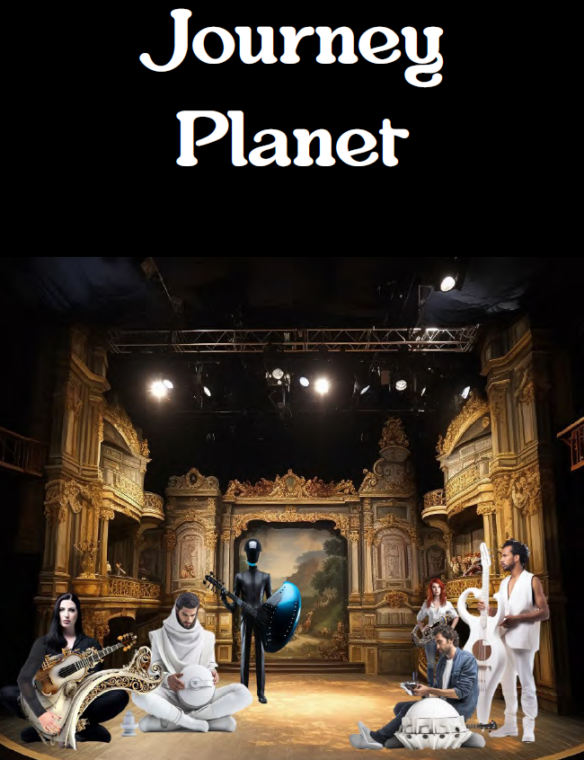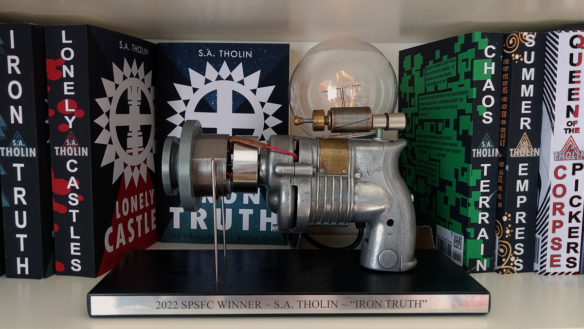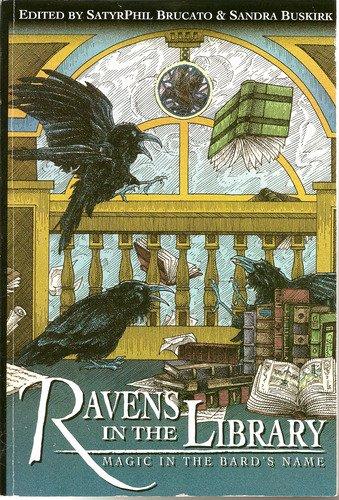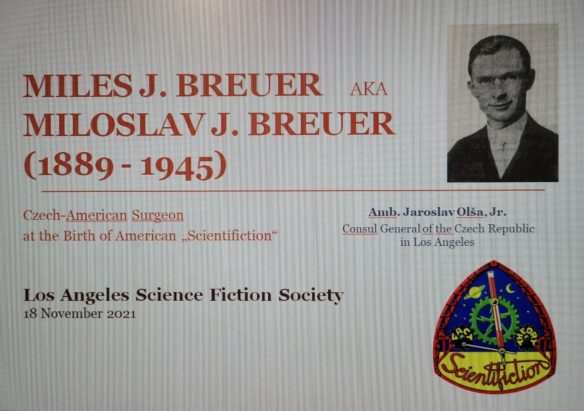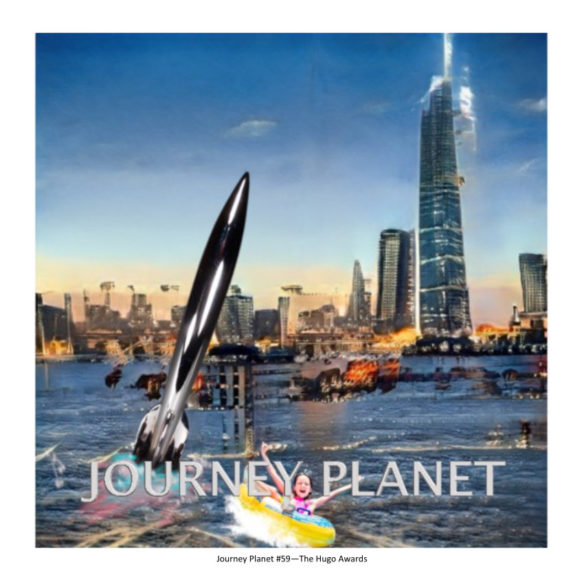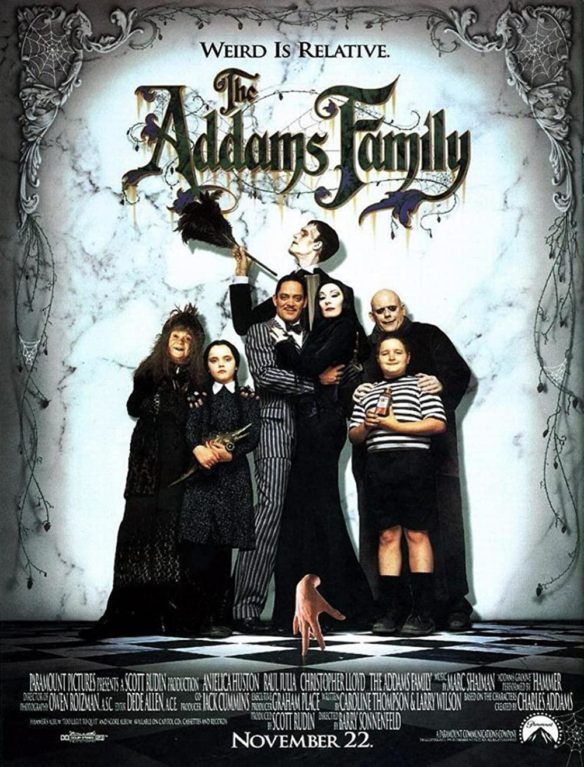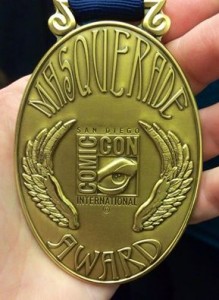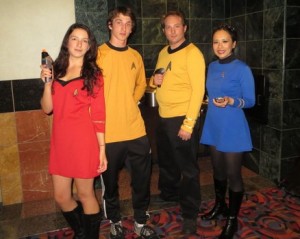(1) WRITE ON DEMAND PUBLISHING. Chuck Tingle wasted no time capitalizing on the Chicago Sun-Times’ gaffe of including numerous AI-hallucinated titles on its summer recommended reading list. He has slightly adjusted the author’s name from Andy Weir to Andy Mirror, which will probably help keep his lawyer happy.
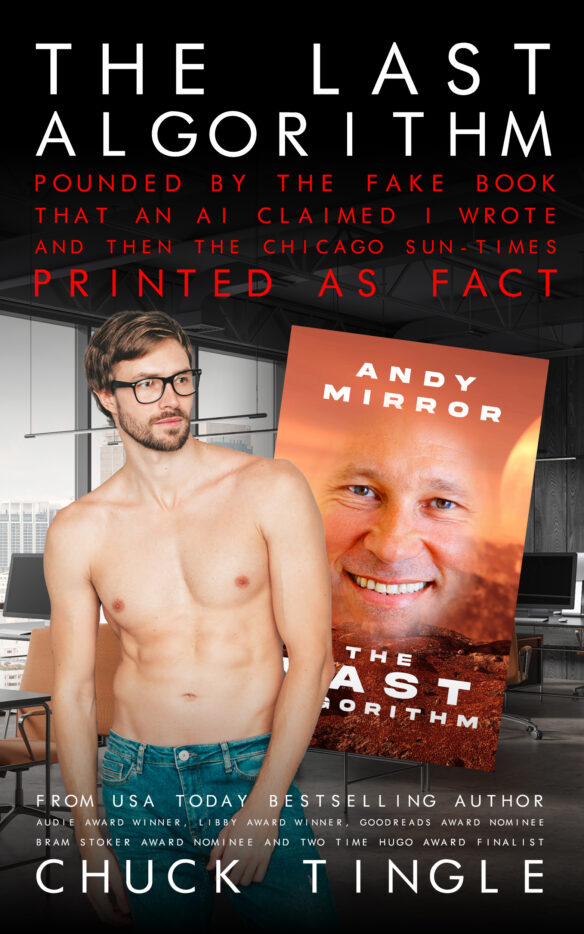
(2) THE ANARCHY AND THE ECSTASY. Molly Templeton argues “Magic Doesn’t Have to Make Sense” at Reactor.
For reasons I’m not sure I will ever fully understand, the topic of magic and rules comes up with slightly alarming frequency in SFF circles. So much so, in fact, that it is very tempting to use ominous capital letters when referring to the two bits of said topic: Magic and Rules. Does magic have to have rules? Would everyone just run about drunk with power if the rules did not constrain their magics in some way? What are rules, and what are parameters? If limits are not imposed upon wizards, will they ever impose them upon themselves? When does magic become science, and how much of this entire topic can I throw at the feet of Clarke’s third law?
That law, for those in need of a refresher, states that any sufficiently advanced technology is indistinguishable from magic. Fair enough. But must we try to reverse-engineer this?…
… I am here instead to sing the praises of rebellious, lawless, delightfully un-rulebound magic—not just the kind people do, but also the kind that simply is. I tried to find an example from Catherynne Valente’s Fairyland books and was overwhelmed with them: the wyverary (half wyvern, half library); Gleam the lamp; the smartly dressed Green Wind; the whole thing with the moon in the third book: Valente writes like she’s never heard of “rules,” and I have never wanted anything in one of her novels explained to me any further than she explains it. Strange, arguably magical things happen in Helen Oyeyemi books, and whenever they—or she—run up against a rule, whether of science or nature or anything else, it goes ignored. A lot of my favorite books, I can’t remember how the magic works. And I mean that as a compliment. In The Incandescent, magic exists, and some people are just better at various kinds of it than others. (Some of it involves invoking demons, and if you mess up that kind, well, magic definitely has a price.) Magic in The Magicians comes from pain. That’s fine. That’s a source, not a rule (one does have to learn fancy hand motions in order to do magic, but that’s a process). It also always kind of feels like a wry punchline to me. Every life has some pain. Therefore we’ve all got some magic….
(3) WRITER BRIEFINGS. [Item by SF Concatenation’s Jonathan Cowie.] BBC Radio 4 (formerly known as the Home Service) has just broadcast two programmes of interest to writers and, I guess, avid readers too.
The first is on the history of copyright through to today. As Filers will know, there has been great author and fan concern over the use of using copyright material to train AI. This is of relevance to the history of copyright which came about due to advances in reproduction technology, from monks’ highly illustrated ad coloured manuscripts to the printing press and digital material. Listen here: BBC Radio 4: In Our Time, “Copyright”.
Copyright protects and regulates a piece of work – whether that’s a book, a painting, a piece of music or a software programme. It emerged as a way of balancing the interests of authors, artists, publishers, and the public in the context of evolving technologies and the rise of mechanical reproduction.
Writers and artists such as Alexander Pope, William Hogarth and Charles Dickens became involved in heated debates about ownership and originality that continue to this day – especially with the emergence of artificial intelligence.
Melvyn Bragg moderates.
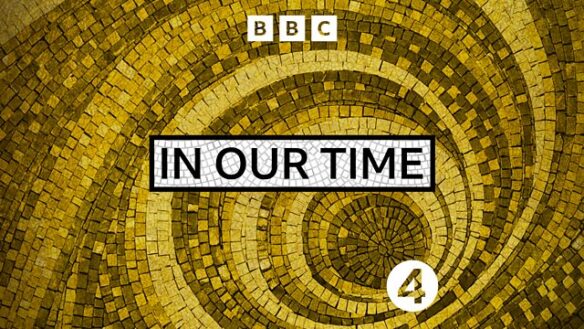
The second is on the way we (society) are (is) changing the use of punctuation. The question mark and exclamation mark is holding its own, but the comma, colon, and eve the full stop is on the way out! Listen here: BBC Radio 4: Word of Mouth, “The End of the Full Stop?”
The use of punctuation is rapidly changing within the quick-fire back-and-forth of instant messaging. Are these changes causing misunderstandings?
Presenter Michael Rosen and his guest Dr Christian Ilbury discuss. Is the full stop on the way out? What about capital letters? Exclamation marks and question marks seem to be holding their ground, but what about the rest?

(4) RECALLING THE FIRST TIME. [Item by Steven French.] Remember the first time you saw Star Wars in the cinema? Well, the Guardian would like to hear from you: “Tell us your memories of seeing Star Wars in cinemas”.
You can tell us your memories of seeing the original Star Wars using this form.
Please share your story if you are 18 or over, anonymously if you wish.
(5) BILL WOULD BLOCK STATES FROM REGULATING AI. “House Republicans want to stop states from regulating AI. More than 100 organizations are pushing back” reports CNN Business.
More than 100 organizations are raising alarms about a provision in the House’s sweeping tax and spending cuts package that would hamstring the regulation of artificial intelligence systems.
Tucked into President Donald Trump’s “one big, beautiful” agenda bill is a rule that, if passed, would prohibit states from enforcing “any law or regulation regulating artificial intelligence models, artificial intelligence systems, or automated decision systems” for 10 years.
With AI rapidly advancing and extending into more areas of life — such as personal communications, health care, hiring and policing — blocking states from enforcing even their own laws related to the technology could harm users and society, the organizations said. They laid out their concerns in a letter sent Monday to members of Congress, including House Speaker Mike Johnson and House Democratic Leader Hakeem Jeffries.
“This moratorium would mean that even if a company deliberately designs an algorithm that causes foreseeable harm — regardless of how intentional or egregious the misconduct or how devastating the consequences — the company making or using that bad tech would be unaccountable to lawmakers and the public,” the letter, provided exclusively to CNN ahead of its release, states.
The bill cleared a key hurdle when the House Budget Committee voted to advance it on Sunday night, but it still must undergo a series of votes in the House before it can move to the Senate for consideration.
The 141 signatories on the letter include academic institutions such as the University of Essex and Georgetown Law’s Center on Privacy and Technology, and advocacy groups such as the Southern Poverty Law Center and the Economic Policy Institute. Employee coalitions such as Amazon Employees for Climate Justice and the Alphabet Workers Union, the labor group representing workers at Google’s parent company, also signed the letter, underscoring how widely held concerns about the future of AI development are….
(6) CALL FOR SUBMISSIONS FOR JOURNEY PLANET AUGUST ISSUE, [Item by Jean Martin.] San Francisco and the Bay Area have inspired cultural and scientific revolutions since the Gold Rush in 1849. Thus, we’re excited to boost the city’s relevance in the science fiction/fantasy genre in the August issue of Journey Planet.
If you have any suggestions for an article, poem, story or art that revolves around San Francisco and science fiction/fantasy, please reach out to us at: journeyplanetsubmissions@gmail.com.
The deadline for submissions is July 1.
For instance, we’d welcome articles about books or movies/TV shows set in San Francisco and its environs and/or created by residents of the SF Bay Area. We’d especially like to hear from diverse voices, such as myths and folktales from the Ohlone and Hispanic cultures. Looking forward to hearing your creative ideas!
(7) FREE READ. A new story from Grist’s “Imagine 2200” – “The Seed Dropper”.
In this poetic story, by simóne j banks, Louisiana native June returns to his hometown decades after devastation from floods and petrochemical plants chased his family away, with a mission to reseed the land and memories from the past to point the way.
Deeply connected to both the beauty of the Mississippi River and the devastation brought by petrochemical plants to the region known as Cancer Alley, The Seed Dropper dabbles in nostalgia and sadness, but also hope and possibility, as it imagines the world of 2050 and the first steps to restoring what’s been lost.
(8) GUFF PAPERBACK RELEASED. The GUFF trip report anthology announced as an ebook in February is now also available in paperback from Ansible Editions: GUFF: The Incomplete Chronicles edited by David Langford. Here’s the full information about the book.
This volume gathers up the chapters of GUFF reports that were unfinished or too short for standalone publication. Donations to GUFF rather than TAFF are encouraged for those who enjoy this one. Download it here.
This book brings together the known segments of unfinished Get Up-and-Over/Going Under Fan Fund trip reports. The GUFF winners represented are Joseph Nicholas (1981), Justin Ackroyd (1984), Irwin Hirsh (1987), Roman Orszanski (1990), Eva Hauser (1992), Paul Kincaid (1999), Damien Warman and Juliette Woods (jointly, 2005) and Ang Rosin (2007).
From the Introduction by David Langford
As with its ancestor fund TAFF, a long-standing tradition of GUFF is that returned winners administer the fund until replaced by their successor from the same hemisphere and if possible write a substantial trip report, both for sale in aid of the fund and for the entertainment and edification of fandom. This tradition goes back to before TAFF itself began. A special fund was organized to bring Walt Willis from Ireland to the USA and the World SF Convention in 1952 (an initiative which led directly to the founding of TAFF), and his report The Harp Stateside is regarded as a classic of fan writing.
Many GUFF winners since 1979 have likewise published full-length trip reports (click here for available downloads). Some were waylaid by the horrors of real life and failed even to begin a report; some published instalments in fanzines but didn’t finish. Joseph Nicholas drafted a very long report whose MS was lost in a house move. Irwin Hirsh has published ten instalments, enough to be called a completed report, but wants to add more and is represented here by two chapters about the UK Worldcon he attended. Otherwise, this ebook collects what remains of reports that have been abandoned, or are so brief that they couldn’t plausibly be published as a standalone fanzine in the tradition of The Harp Stateside. There’s a lot of fine fan writing here.
This GUFF-centred companion to the TAFF Trip Report Anthology (2017) is published as an Ansible Editions ebook for the TAFF site on 1 March 2025. Cover artwork by Ian Gunn. 73,000 words.
(9) STARTS TOMORROW. Fountain of Youth – Official Trailer. The best secrets are the hardest to find. John Krasinski, Natalie Portman, Eiza González and Domhnall Gleeson star in Fountain of Youth. Premiering May 23 on Apple TV+
(10) MEMORY LANE.
[Written by Cat Eldridge.]
May 22, 1981 — Outland film
Outland premiered forty-four years ago this date in the States in select cities, but everywhere that following weekend. It got a Hugo nomination at Chicon IV, the year that Raiders of the Lost Ark won.
This original title of the film was Io as it’s set on Jupiter’s moon Io, but audience testing showed that wasn’t understandable at all as the test audiences thought it was the number ten, or, at least to me less puzzlingly, low. So in homage to the Western genre, it became Outland.
Which was appropriate as the writer Peter Hyams wanted to do one: “I wanted to do a Western. Everybody said, ‘You can’t do a Western; Westerns are dead; nobody will do a Western’. I remember thinking it was weird that this genre that had endured for so long was just gone. But then I woke up and came to the conclusion – obviously after other people – that it was actually alive and well, but in outer space.”
So they had a script that they really liked, now they need their actor. They wanted and got Sean Connery to be in their version in High Noon. Connery’s career had been in a nose dive as of late then, so this was a golden chance for him, so he took the role.
Law enforcement officers are faced with the nature of right and wrong, and duty versus keeping themselves safe, but while Will Kane in High Noon is played as an archetypal hero who discovers the world isn’t black and white as he was led to believe, Will O’Niel already exists firmly in the gray where things are always messy when we meet him.
Connery was magnificent in this role. In addition to Sean Connery, the movie includes performances by Peter Boyle, Frances Sternhagen, and James Sikking, who all I firmly believe deliver memorable portrayals of complex characters.
So they got the lead and the rest of an excellent core cast, now they had to film a movie. They had a very tight budget, just seventeen million dollars. The quite amazing sets were enhanced by the use of a new filming process called Introvision which allowed the director to mix a combination of sets, mattes and a generous use of miniatures in-camera, avoiding the then-lengthy process of extensive use of green screens.
Critics were mixed on it. Gary Arnold at the Washington Post thought it was “trite and dinky” whereas Desmond Ryan at the Philadelphia Inquirer called it: “a brilliant sci-fi Western.”
I said it cost seventeen million to make, and it made, errr, just about seventeen million dollars. That means that it lost money for the studio. Lots by the time you figure printing up reels for the theatres, promotional costs and that the studio only gets fifty percent most often of ticket sales. Not that the studio would admit that.
Now I liked the film. I saw it some years after it came out and thought it worked rather well, but then I think it is police drama rather than a SF film.
It is not legally streaming anywhere so you know that linking to it is a bad idea, right?

(11) COMICS SECTION.
- Bizarro moves a show to a different state.
- Mother Goose and Grimm discover a misleading name.
- Rubes knows you know the answer.
- Saturday Morning Breakfast Cereal finds writers that other writers can’t stand.
- The Other Coast is barking mad.
(12) WHAT’S THE BEST WAY FOR A MUSIC FAN TO SUPPORT THEIR FAVORITE ARTISTS? [Item by John A Arkansawyer.] This is an interesting look at how fandom and commerce interact, focusing on music but of interest, I think, to fans more generally. NPR asks “Is there a right way of being a music fan?”
…I offer these two stories to highlight the contrasting conceptions of what constitutes fandom in 2025. In the first case, the fan is a customer looking for the best deal. In the second, she is a patron, supporting a creative favorite not only with money but through sustained attention and care. Both terms stick the artist within a somewhat servile position, delivering goods, but the latter feels more genteel and possibly more sustaining. “Customer” implies a one-way relationship, with the artist cast as a seller; “patron” suggests an ongoing connection through which a fan ardently supports an artist for a time or over a whole career….
… Today, “always on” artists have to be far more responsive to their fans’ desires. This means providing more music, but also many other means of consumption and interaction, from VIP concert experiences to TikTok videos, special merch lines, and, for an increasing number of artists, OnlyFans or Patreon accounts that grant direct access. Much commentary exists on the ever-growing power of the fan, but I’m interested in how fans negotiate this partly real, partly imagined surge in influence, and what it means for artists at a moment when their role in society has never been less clear….
(13) AI CHATBOTS DO NOT HAVE FREE SPEECH RIGHTS. [Item by Mark Roth-Whitworth.] So says the judge. “In lawsuit over teen’s death, judge rejects arguments that AI chatbots have free speech rights” – AP News has the story.
A federal judge on Wednesday rejected arguments made by an artificial intelligence company that its chatbots are protected by the First Amendment — at least for now. The developers behind Character.AI are seeking to dismiss a lawsuit alleging the company’s chatbots pushed a teenage boy to kill himself.
The judge’s order will allow the wrongful death lawsuit to proceed, in what legal experts say is among the latest constitutional tests of artificial intelligence.
The suit was filed by a mother from Florida, Megan Garcia, who alleges that her 14-year-old son Sewell Setzer III fell victim to a Character.AI chatbot that pulled him into what she described as an emotionally and sexually abusive relationship that led to his suicide.
Meetali Jain of the Tech Justice Law Project, one of the attorneys for Garcia, said the judge’s order sends a message that Silicon Valley “needs to stop and think and impose guardrails before it launches products to market.”…
(14) ROCKETSHIPS IN QUEENS? Untapped New York tours “Rocket Park, a Space Age Remnant of NYC’s 1964 World’s Fair”.
Peeking over the foliage outside the Hall of Science in Flushing Meadows-Corona Park are two towering metal structures you wouldn’t expect to find in Queens, rocketships. These space-age remnants are relics of the United States Space Park, an attraction created by NASA and the Department of Defense for the 1964 World’s Fair. These vessels aren’t even the first rockets to come to New York City. In 1957, a Redstone rocket was put on display in the main concourse of Grand Central Terminal. While the Redstone rocket was only a temporary fixture, you can still see the World’s Fair’s rockets today in Rocket Park, a playground area outside the Hall of Science….
… The fair was buzzing with excitement over the final frontier. Streets in the park’s radial grid pattern had names like Universe Court, Astronaut Court, Avenue of Science, and Avenue of Discovery. Visitors would find the iconic Unisphere in the Fountain of the Planets. The space motif is also exemplified in the Rocket Thrower, a massive bronze statue by Donald DeLue. The Rocket Thrower is posed in motion as he hurtles a rocket towards a constellation of gilded stars….
… The United States Space Park at the World’s Fair gave people a chance to see space travel technology, which they heard so much about on television, up-close in real life….
(15) MINI TRYLON AND PERISPHERE. And here’s a memory from even earlier, New York’s 1939 World’s Fair. “A Trylon and Perisphere Replica Once Stood at the Lincoln Tunnel”.
Searching the World’s Fair archives, Untapped New York’s founder Michelle Young came upon a forgotten gem: a mini Trylon and Perisphere replica that once stood at the New Jersey entrance of the Lincoln Tunnel. This information booth structure was meant to be eye-catching and to “induce the out-of-town motorist to stop at the booths before plunging into Manhattan.” The Trylon and Perisphere were the centerpieces of the 1939 World’s Fair and this piece of promotional architecture was one of many replicas that popped up around NYC to promote the fair….

(16) NO WONDER THEY’RE ‘THE LAST’. The Guardian’s episode recap stirs up a panic: “’I didn’t sign up for a musical!’ Are the guitar sing-alongs killing The Last of Us?”
This week’s episode of The Last of Us contained a moment that froze the blood. For a split second, the hearts of the viewing audience rose into their throats in horror. This is a show that has presented us with terror after nightmarish terror but, even by these exceptional standards, this was almost too much to bear. I am talking, of course, about the scene where Ellie started playing a Pearl Jam song on a guitar.’
(17) TRAILER PARK. “Universal Drops ‘Jurassic World Rebirth’ Final Trailer” – Animation World Network sets the scene.
It’s a survival story, harkening back to the original, iconic Jurassic Park. Universal has just dropped the final trailer for its upcoming badass dino adventure, Jurassic World Rebirth, in theaters July 2.
With lots of big, sharp, pointy teeth!
The huge Jurassic franchise is back with its latest adventure, set five years after the events of Jurassic World Dominion, filled with biting humor and biting creatures… including raptors! And Pterywhatevers! Johansson, Bailey and Mahershala Ali anchor an all-star cast as an extraction team, hunting potentially life-saving DNA at the original Jurassic Park’s research facilities, that happens to be inhabited by the worst of the worst dinosaurs that were left behind. The film also stars Rupert Friend and Manuel Garcia-Rulfo….
[Thanks to John King Tarpinian, Chris Barkley, Cat Eldridge, Jean Martin, David Langford, John A Arkansawyer, SF Concatenation’s Jonathan Cowie, Mark Roth-Whitworth, Steven French, Kathy Sullivan, Teddy Harvia, Mike Kennedy, and Andrew Porter for some of these stories. Title credit belongs to File 770 contributing editor of the day Andrew (not Werdna) (and not Gene Wolfe, either).]


